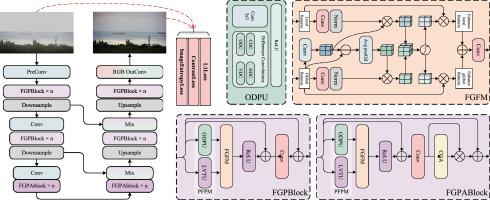Maritime image dehazing based on Omni-Directional Perception and frequency-guided fusion
IF 3
3区 工程技术
Q2 ENGINEERING, ELECTRICAL & ELECTRONIC
引用次数: 0
Abstract
Maritime image dehazing plays a crucial role in visual navigation and environmental perception. While existing methods based on physical models and deep learning have achieved certain progress in enhancing image contrast and detail restoration, they still face challenges in insufficient target detail extraction and over-smoothed backgrounds in complex maritime scenarios. To address these issues, this paper proposes an innovative network architecture featuring parallel feature perception and frequency-guided fusion, which improves dehazing performance through three aspects: feature extraction, feature fusion, and information optimization. Specifically, the Omni-Directional Perception Module enhances the perception of complex features by strengthening high-frequency target detail and low-frequency background feature extraction. The Frequency-Guided Feature Fusion Module achieves efficient local-global feature fusion through frequency decomposition and dynamic weighting mechanisms. The Discrete Entropy Constraint Loss further improves the naturalness and detail fidelity of dehazed results by optimizing image information distribution. Experimental results demonstrate that our method significantly enhances detail representation and background naturalness in complex scenarios, providing a promising solution for marine image dehazing.

基于全方位感知和频导融合的海洋图像去雾
海洋图像去雾在视觉导航和环境感知中起着至关重要的作用。虽然现有的基于物理模型和深度学习的方法在增强图像对比度和细节恢复方面取得了一定的进展,但在复杂的海事场景中,它们仍然面临目标细节提取不足和背景过度平滑的挑战。针对这些问题,本文提出了一种基于并行特征感知和频率引导融合的创新网络架构,从特征提取、特征融合和信息优化三个方面提高了去雾性能。具体来说,全方位感知模块通过加强高频目标细节和低频背景特征提取来增强对复杂特征的感知。频率引导特征融合模块通过频率分解和动态加权机制实现高效的局部-全局特征融合。离散熵约束损失通过优化图像信息分布,进一步提高去雾结果的自然度和细节保真度。实验结果表明,该方法显著增强了复杂场景下的细节表示和背景自然度,为海洋图像去雾提供了一种很有前景的解决方案。
本文章由计算机程序翻译,如有差异,请以英文原文为准。
求助全文
约1分钟内获得全文
求助全文
来源期刊

Digital Signal Processing
工程技术-工程:电子与电气
CiteScore
5.30
自引率
17.20%
发文量
435
审稿时长
66 days
期刊介绍:
Digital Signal Processing: A Review Journal is one of the oldest and most established journals in the field of signal processing yet it aims to be the most innovative. The Journal invites top quality research articles at the frontiers of research in all aspects of signal processing. Our objective is to provide a platform for the publication of ground-breaking research in signal processing with both academic and industrial appeal.
The journal has a special emphasis on statistical signal processing methodology such as Bayesian signal processing, and encourages articles on emerging applications of signal processing such as:
• big data• machine learning• internet of things• information security• systems biology and computational biology,• financial time series analysis,• autonomous vehicles,• quantum computing,• neuromorphic engineering,• human-computer interaction and intelligent user interfaces,• environmental signal processing,• geophysical signal processing including seismic signal processing,• chemioinformatics and bioinformatics,• audio, visual and performance arts,• disaster management and prevention,• renewable energy,
 求助内容:
求助内容: 应助结果提醒方式:
应助结果提醒方式:


